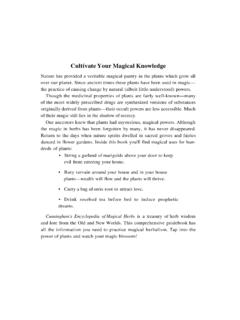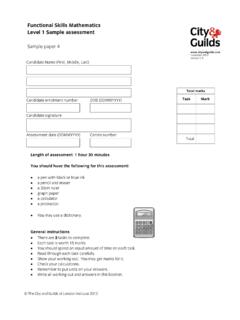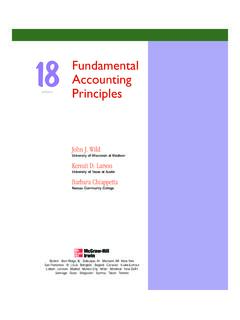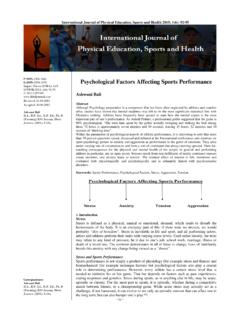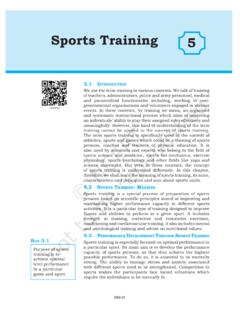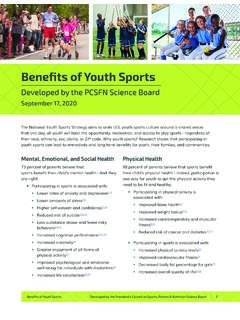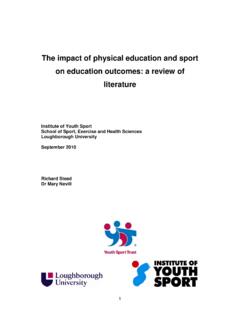Transcription of Sport Psychology: A Students's Handbook
1 Sport PSYCHOLOGYThis book offers a student-friendly introduction to the discipline of Sport psy-chology. All the key psychological issues in Sport are explored and illustrated withsporting examples. Throughout, difficult questions are raised: are athletes bornor made? Does participating in Sport affect personality? What impact do culturalbeliefs have on personal sporting development? These complex issues areweighed up to provide a detailed overview of the topic. Matt Jarvis has substan-tially revised and expanded his original coverage of the subject from his highlysuccessful book Sport psychology (published by Routledge in 1999). Here he pro-vides a succinct but comprehensive account of major theory and research in sportpsychology, whilst maintaining the readable style and student-centred approachwhich made the previous book so issues covered include: personality and Sport attitudes to Sport aggression in Sport the social factors affecting performance arousal and anxiety motivation and skill is an emphasis not merely on learning about Sport psychology , but alsoon developing critical and creative thinking.
2 In addition, the book includeschapters on conducting research and writing essays in Sport psychology , as wellas reflective exercises throughout the by a successful author who has experience of teaching at sixth formand undergraduate level, this book will be useful to undergraduates in sportscience and leisure management, those studying for the BAQTS and PGCE inphysical education, and those studying A-level psychology or sports Jarvis teaches psychology at Totton College and is Visiting Lecturer atSouthampton PsychologyA Student s HandbookMatt JarvisFirst published by Routledge27 Church Road, Hove, East Sussex, BN3 2 FASimultaneously published in the USA and Canadaby Routledge270 Madison Avenue, New York, NY 10016 Routledge is a part of the Taylor & Francis GroupCopyright 2006 RoutledgeAll rights reserved. No part of this book may be reprinted or reproduced or utilised in any formor by any electronic, mechanical, or other means, now known or hereafter invented, includingphotocopying and recording, or in any information storage or retrieval system, withoutpermission in writing from the publisher makes no representation, express or implied, with regard to the accuracy of theinformation contained in this book and cannot accept any legal responsibility or liability for anyerrors or omissions that may be publication has been produced with paper manufactured to strict environmental standardsand with pulp derived from sustainable Library Cataloguing in Publication DataA catalogue record for this book is available from the British LibraryLibrary of Congress Cataloging in Publication DataJarvis, Matt, 1966 Sport psychology .
3 A student s Handbook / Matt bibliographical references and 1 -84169-581-5 (hardcover) ISBN 1-84169-582-3 (softcover)1. sports Psychological aspects Handbooks, manuals, etc. I. dc22 ISBN10: 1-84169-581-5 (hbk) ISBN13: 978-1-84169-581-5 (hbk)ISBN10: 1-84169-582-3 (pbk) ISBN13: 978-1-84169-582-2 (pbk)This edition published in the Taylor & Francis e-Library, 2006. To purchase your own copy of this or any of Taylor & Francis or Routledge scollection of thousands of eBooks please go to ContentsList of figures and tablesixPreface to second editionxi1. Introduction1 What is Sport psychology ?1A brief history of Sport psychology2 What is a Sport psychologist?3 For those new to psychology5 Summary and conclusions112. Personality characteristics and sporting behaviour13 Trait theories14 Research into traits and sporting behaviour19 Narrow-band theories of personality22 Attentional style27 Discussion of the trait and narrow-band approaches29 Situational and interactional approaches30 Summary and conclusions333.
4 Personality development and sport35 Social learning theory36 Applying social learning theory to sport37 Sources of influence on social development and sport40 Gender and sport42 Sport as an influence on social development46 The psychodynamic approach to personalitydevelopment49 Summary and conclusions534. Attitudes to sport55 The nature of attitudes56 Measuring attitudes58 The formation of attitudes to sport61 Attitudes to competition64 Attitudes to Sport and sporting behaviour65 CONTENTSvChanging people s attitudes to sport69 Summary and conclusions715. Aggression and sport73 Defining aggression74 The link between aggression and performance76 Theories of aggression79 Individual differences in sporting aggression83 Situational factors affecting aggression85 The $64,000 question does Sport increase or reduceaggression?86 The reduction of aggression88 Summary and conclusions906. Social factors in sporting performance93 Groups and teams93 Social facilitation97 Negative effects of team membership102 Leadership104 Summary and conclusions1107.
5 Arousal, anxiety and sporting performance113 Definitions of arousal, anxiety and stress114 Factors inducing anxiety and stress118 The relationship between arousal and performance120 The relationship between anxiety and performance122 Stress management127 Summary and conclusions1338. Motivation and sport135 Intrinsic and extrinsic motivation136 Theories of motivation138 Self-efficacy147 Counterfactual thinking148 Pathological motivation and sport150 Summary and conclusions1529. Skill acquisition and expertise155 Definitions156 Classifying abilities156 Classifying skills158 Two linked issues: the existence of superabilityand the nature nurture debate in sport160 Stages of skill acquisition163 The information-processing approach to skills166 Memory167 Theories of motor learning170viCONTENTSE xpert performance172 Enhancing skill and expertise: the role of practice174 Summary and conclusions17710.
6 Research methods in Sport psychology179 Quantitative and qualitative research180 The experimental model180 The correlational method184 Survey methods187 Case studies190 Archival studies191 Review methods192 Summary and conclusions19411. Writing essays in Sport psychology197 Seven deadly sins of essay writing197 Content199 Structure203 Style207 Conventions208 Summary and conclusions213 References215 Index229 CONTENTSviiList of figuresand Eysenck s four personality What personality differences can you see between golfers andsurfers? The relative importance of personality, situation and otherfactors in athletic Mood profiles of elite and unsuccessful Children witnessing this behaviour may imitate David Children imitate family role Feminine roles can be hard to reconcile with Female athletes are evaluated by commentators for looks andpersonality rather than Boxing arouses strong Social learning of a child s attitude to Applying the theory of reasoned action to explaining participa-tion in There is always a decision-making process involved in choosingto participate in The greater the potential for serious injury, the more elaborateare the rules for preventing Although (American)
7 Ice hockey is notoriously violent, there isno clear link between aggression and Bandura s famous bobo doll 9/11 triggered a reaction against war Martial arts training tends to reduce The effect of being watched on pool players will depend on theirlevel of Drive theory of the relationship between arousal and perform-ance for expert The inverted-U hypothesis of arousal and performance122 LIST OF FIGURES AND Fazey & Hardy s catastrophe model of the relationship betweenanxiety and The relationship between arousal and bowls performance underlow and high cognitive Zones of optimal functioning in three Jack Nicklaus places tremendous emphasis on Visualising a stadium before competition may Karate belts are an example of the effective use of Maslow s hierarchy of Fitting reasons for Sport participation into the hierarchy Martial arts differ in the use of a predominantly task- or
8 Ego-oriented Fencing self-efficacy is affected by winning and Weiner s model of After this incident in 1998, the country engaged in counterfac-tual Weightlifting requires the ability of dynamic Examples of sporting skills ranging from gross to This martial artist is practising a closed skill, but with sufficientpractice should be able to use it in an open This child basketball prodigy did not develop the necessaryphysical characteristics for adult Michael Jordan is a classic example of an athlete practising at theautonomous Welford s information-processing Anderson s model of Closed loop Some correlation An effect size of one standard Bloom s taxonomy of thinking A spider psychological approaches to theoretical orientations in of task- and ego-oriented of some internal and external attributions of motor abilities and dependent skills156xLIST OF FIGURES AND TABLESP reface to thesecond editionFollowing the success of the first edition of Sport psychology , whichwas written primarily for A-level students, the aim of this secondedition is to make the book of more use to students at undergraduatelevel.
9 To achieve this, I have tried to maintain the informal, user-friendly style of the first edition, but I have also added substantially tothe content. Thus, the text is much more detailed and up-to-date, fea-turing a more comprehensive range of theories and numerous studiesfrom the last 5 years. Chapters 2 9 cover the essential topics in sportpsychology; personality and Sport , attitudes to Sport , aggression andsport, social factors affecting performance , arousal and anxiety ,motivation, and the acquisition of skill and expertise. Throughout thebook, I have rejected utterly the just do it attitude that characterisessome Sport science literature. Instead there is an emphasis on thrash-ing out difficult issues, including the questions of whether athletes areborn or made, and whether Sport is really character real understanding of Sport psychology , it is necessary to havea reasonable understanding of the nature of psychology itself.
10 One ofthe things I have tried to do in this second edition is to put across tothose new to studying psychology at this level the nature of the disci-pline. In Chapter 1, the reader is introduced to the distinction betweentheory and research and the range of theoretical approaches that makeup psychology . However, psychology is as much a way of thinking asa set of theories and studies. I have tried to introduce the reader to theskills of critical and creative thinking prized by psychologists, and toencourage the use of these higher thinking skills throughout the bookwith a series of reflective of use to those new to psychology should be the final twochapters. In Chapter 10, I review the major research methods used insport psychology . This should help students both to understand morePREFACE TO SECOND EDITION xideeply the research they have studied already and to plan their ownresearch.
